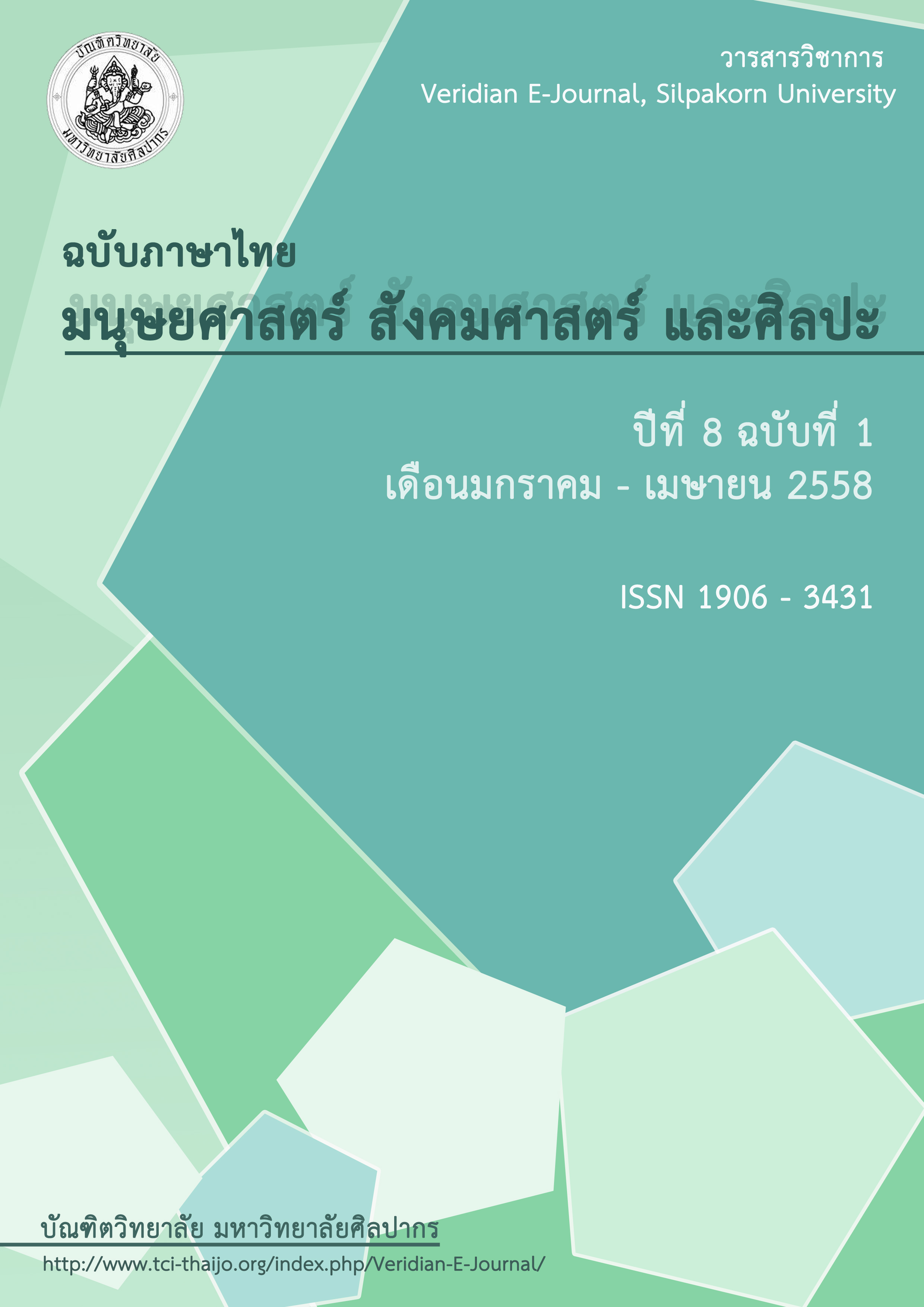การเปรียบเทียบการพูดและการเขียนจากการเล่าเรื่องของเด็กออทิสติก
Main Article Content
Abstract
บทคัดย่อ
งานวิจัยนี้มีวัตถุประสงค์เพื่อศึกษาเปรียบเทียบความสัมพันธ์ระหว่างการออกเสียงและการเขียนสะกดคำ ชนิดของคำ ชนิดและโครงสร้างของวลี ประโยครวมทั้งสัมพันธสารจากการพูดและการเขียนเล่าเรื่องของเด็กออทิสติก ผู้วิจัยเก็บข้อมูลจากนักเรียนออทิสติกโรงเรียนสาธิตแห่งมหาวิทยาลัยเกษตรศาสตร์ จำนวน 7 คน โดยให้นักเรียนแต่ละคนเล่าเรื่องคนละ 8 เรื่องจากแผ่นภาพที่กำหนดให้ 8 ภาพ แบ่งเป็นการ พูดเล่าเรื่อง 4 เรื่อง และเขียนเล่าเรื่อง 4 เรื่อง การเก็บข้อมูลครั้งนี้ได้เรื่องเล่าที่นำมาศึกษาทั้งสิ้น 56 เรื่อง
ผลการศึกษาพบว่าการพูดเล่าเรื่องมีอัตราการปรากฏรูปแปรของพยัญชนะทุกชนิดที่ปรากฏร่วมกันมากกว่าการเขียนเล่าเรื่อง ส่วนการเขียนเล่าเรื่องมีอัตราการปรากฏรูปแปรของสระทุกชนิดที่ปรากฏร่วมกันรวมทั้งวรรณยุกต์มากกว่าการพูดเล่าเรื่อง เมื่อพิจารณาความสัมพันธ์ระหว่างการออกเสียงและการเขียนสะกดคำของเด็กออทิสติกพบว่าส่วนใหญ่มีความสัมพันธ์กัน ด้านการใช้คำ วลีและประโยคพบว่าการพูดเล่าเรื่องปรากฏจำนวนคำ วลี และประโยคทุกชนิดมากกว่าการเขียนเล่าเรื่อง เมื่อพิจารณาคำและวลีพบว่าชนิดของคำที่ปรากฏมากที่สุดในวิธีการเล่าเรื่องทั้งสองรูปแบบ คือ คำนาม ส่วนชนิดของวลีที่ปรากฏมากที่สุดในวิธีการเล่าเรื่องทั้งสองรูปแบบคือ นามวลี ทั้งนี้โครงสร้างนามวลีที่ปรากฏจากการพูดเล่าเรื่องคือโครงสร้างแบบหน่วยหลัก ส่วนโครงสร้างนามวลีที่ปรากฏจากการเขียนเล่าเรื่องคือโครงสร้างแบบหน่วยหลัก-หน่วยจำนวน เมื่อพิจารณาประโยคพบว่าวิธีการเล่าเรื่องทั้งสองรูปแบบปรากฏการใช้ประโยค 3 ชนิด ได้แก่ ประโยคสามัญ ประโยคซับซ้อน และประโยคผสม โดยประโยคสามัญเป็นประโยคที่ปรากฏมากที่สุดในวิธีการเล่าเรื่องทั้งสองรูปแบบ โครงสร้างที่ปรากฏมากที่สุดคือโครงสร้างแบบกริยาอกรรม ส่วนโครงสร้างประโยคซับซ้อนที่ปรากฏมากที่สุดจากการพูดเล่าเรื่องคือโครงสร้างแบบประธาน-กริยาสกรรม-กรรมตรง ส่วนโครงสร้างที่ปรากฏมากที่สุดในการเขียนเล่าเรื่องคือโครงสร้างแบบกริยาสกรรม-กรรมตรง ด้านการวิเคราะห์สัมพันธสารพบว่าวิธีการเล่าเรื่องทั้งสองรูปแบบปรากฏวิธีการเริ่มต้นเรื่องด้วยการกล่าวถึงตัวละครมากที่สุด การพูดเล่าเรื่องปรากฏการลงท้ายด้วยการใช้วลียุติเรื่องเล่ามากที่สุดและการเขียนเล่าเรื่องปรากฏการลงท้ายด้วยการแสดงบทสรุปของเหตุการณ์ในเรื่องมากที่สุด ด้านการเชื่อมโยงความสรุปได้ว่าวิธีการเล่าเรื่องทั้งสองปรากฏกลวิธีการเชื่อมโยงความร่วมกัน 4 ประเภท ได้แก่ การอ้างถึง การใช้คำเชื่อม การซ้ำ และการเชื่อมโยงคำศัพท์ ส่วนการละไม่ปรากฏในการพูดเล่าเรื่อง เมื่อเปรียบเทียบค่าร้อยละของการเชื่อมโยงความแต่ละประเภทพบว่า การพูดเล่าเรื่องปรากฏการใช้คำเชื่อมและการซ้ำมากกว่าการเขียนเล่าเรื่อง ส่วนการเขียนเล่าเรื่องปรากฏการเชื่อมโยงคำศัพท์และการอ้างถึงมากกว่าการพูดเล่าเรื่อง
Abstract
The purpose of this research is to investigate the relationship between autistic children’s pronunciation, spelling, wording, phrases, sentences, and discourse employed in the spoken and written narrative stories. Data collected from autistic children studying at the Demonstrative School, Kasetsart University are 56 narrative stories prompted by eight pictures; four pictures for the spoken narrative stories and the other ones for the written narrative stories.
The analysis of data reveals that the spoken narrative stories have more consonant variations than the written narrative stories. The written narrative stories have more vowel and tonal variations than the spoken narrative stories. The pronunciation of words by autistic children mostly correspond to their spellings. As for the analysis of words, phrases and sentences employed, the samples employ more words, phrases and sentences in the spoken narrative stories than the written narrative stories. Words which appear most in both types of narrative stories are nouns whereas phrases which appear most in both types of stories are noun phrases. The pattern of noun phrases which appears in the spoken narrative stories is head noun whereas the pattern of noun phrases which appears in the written narrative stories is head noun followed by quantifiers. As for the analysis of sentences employed, the samples employed three types of sentences in both types of narrative stories, namely the simple sentence, the complex sentence and the compound sentence. The simple sentence appears most in both types of narrative stories and employs intransitive verb whereas the complex sentence appears most in the spoken narrative stories and employs the pattern of subject followed by transitive verb and direct object. The pattern employed in the written narrative stories is transitive verb followed by direct object. The analysis of discourse reveals that both types of narrative stories mostly employ the reference to the characters at the introduction. The samples end the spoken narrative stories mostly with phrases to end and the written narrative stories mostly with conclusions. As for the cohesion, both types of narrative stories employ four types of cohesion, namely reference, conjunction, repetition and lexical cohesion. The ellipsis does not appear in the spoken narrative stories. The comparison by percentage of cohesion in both types of narrative stories reveals that the spoken narrative stories employ more conjunction and repetition than the written narrative stories whereas the written narrative stories employ more lexical cohesion and reference than the spoken narrative stories.
